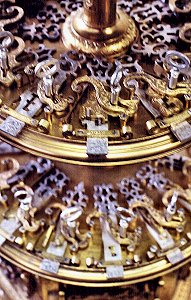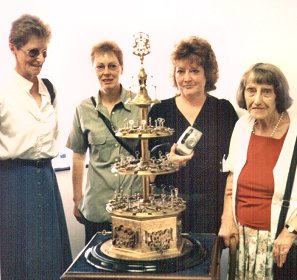|
Charles Aubin was born on the 29th Nov 1812, the son
of Charles David Aubin, an ornamental glass-blower from France. I
have traced the family as far back as the 1680s and have found
that the family name was usually St. Aubin. Charles seems to have
been the only man in the family not to have used the
"St." The only time I have found him using
it was in the 1871 census.
Charles laboured under "humble circumstances"
(Price) and first surfaced in 1830 with a ‘Guardian’ patent
lock when he was18 years old. Here was a talent more precocious
than that of Joseph Duce with his 1823 lock. Charles Aubin
advertised as a locksmith of Wolverhampton in 1838 and by the year
1842 had invented a latch-bolt lock. It proved expensive to make.
Few were sold, the asking price of ten shillings being too
expensive.
Practical costing was his besetting weakness. He lacked the
ability to design locks to an acceptable retail price. In 1845 he
tried again with similar results. And there was a predictability
about the fate of his compound lever lock of 1850; but that does
indicate that the lock cabinet was by no means the sole outlet for
his design resourcefulness.
Aubin’s locks were manufactured in his early and middle years
in Spicer’s Buildings, Pountney Street, Wolverhampton. A western
tributary of Dudley Road, this street was described as ‘intended’
in 1827, so by 1830, when Aubin is first found there, the mortar
of these dwellings was scarcely dry. A near neighbour was Joseph
Duce, so doubtless there would be a great deal of professional
exchanges between these men of common French origin.

The Aubin Trophy. Each
lock could be opened or closed individually with its own
key or all the locks could be operated together by a
single lever arm at the top. |
By the year 1847 he was manufacturing the Bramah lock and, in
1851, the ‘best gunlocks’. He even manufactured for George
Price himself. Later George patented Charles’s design as his
own. Charles also worked for Samuel Chatwood, another powerful
competitor in the safe industry.
Also by 1851 he had a wife and
nine children to support. (He had had twelve children but only
nine survived). The eldest sons were already working for
their father by the time they were 13 years old, and would be
familiar with the steam engine and with the then comparatively
rare key cutting machine. Like Parsons, Charles soon abolished the
steel spring in favour of those made of brass.
Aubin's wife, Elizabeth, died between 1851 and 1861, and
Charles married Annie Morris, who seems to have had a small
millinery business and called herself Anne St Aubin, using the
surname of Charles’s grandfather.
In the 1861 census Charles and
Annie were living in Darlington Street with just Charles's
daughter Ann. That must have been Annie's place of
business. The daughter Anne married into another well
known (at that time) lock-making family, the Braziers of the
Ashes, Brickkiln Street. |
When he was listed in the 1860 Post Office Directory he had set
up his new ‘Guardian’ works, (using the name of his 1830
patent lock), at 25 Great Hampton Street, where he is described as
manufacturing patent iron locks. In the 1871 census he is shown as
living in Waterloo Road with his wife, daughter Jane and son
Frederick. At one time he also set up house in Lowe St. In
the Wolverhampton Trade Directory for 1873 he is living at Fern
House, Bath Road, and still owns the Guardian works, employing 22
men and 6 boys. The electoral roll of 1877 shows him living in
Hunter Street in St. Mark's ward.
As a direct result of his prestige in the lock trade, he was
appointed works manager at Nettlefold’s Guardian Works in
Whitmore Reans, a connection that lasted until about 1879. He then
moved to West Derby, Liverpool, in the employ of the Milner Safe
Company.
Charles Aubin died in Liverpool in May 1883.
The Aubin "Trophy"
This famous trophy was conceived in 1849 for display at the
Great Exhibition of 1851. Aubin used more than 3,000 parts in the
compilation of his chosen locks and their connecting mechanisms.
Very likely he would have employed apprentices to help him in its
assembly. It was a demonstration as to how alike locks were and,
as Price remarked, '… how one inventor has copied another…’.
|
"The Crystal Palace and its Contents" (published by
W. M. Clark, London, 1852) says: "A contrivance by Aubin, of
Wolverhampton, contained the movements of the most celebrated
locks (37 specimens) which, with their connected mechanism,
contained upwards of 3,000 parts, all put in motion by the arm of
a lever communicating by hidden works". This was what became
known as the Aubin "trophy".
In the 1961 edition of the Complete Oxford Dictionary a ‘cabinet’
is described as ‘… ornamental piece … fitted with shelves
… for the proper preservation and display of a collection of
specimens…’. This definition describes exactly what Aubin was
trying to achieve in his lock presentation.
However the ‘cabinet’
in question is now almost invariably called a ‘trophy’, a
definition with connotations nearer to spoil, loot, valour, and
the prizes of victory in war. Tomlinson called Aubin’s
collection a ‘trophy’ in 1853, as did Price in 1856, Hobbs in
1868, the Commissioners of Patents for Inventions in 1873.
|

A part of the trophy
showing Aubin's lock no.26, the lock he introduced in
1830. Note the intricate detail. |
For the duration of the Great Exhibition in Hyde Park, the lock
trophy was in all probability seen as a sophisticated mechanical
toy by many of the 42,381 visitors who were in average daily
attendance. Price’s reaction is on record. He thought the trophy
‘ingenious’. It is an artefact which cannot be overlooked by
the lock historian. Doubters should examine it and observe that in
strong light it still burns like gold. Aubin himself complained of
its ‘glare’ in 1851. The trophy is an intimate work of a size
easily accommodated in a modern living room and its mechanism
displays craftsmanship of a kind expected from a man of Huguenot
background, a breed of men excelling in areas like engraving,
gunsmithing, clockmaking, tapestry work and designing in precious
metals.
During the exhibition the American locksmith, A. C. Hobbs,
insisted on buying the trophy. Hobbs' company, Hobbs Hart, was
bought out by Chubbs and the trophy went to that company. It is now
with Chubbs Safes and, I understand, is about to be restored to
its original glory.
Locks invented by Charles Aubin
as listed in Fire and Thief Proof Depositories by George Price,
1856.
c. 1830 Lock consisting of one tumbler under the
bolt and three more levers on the top of the bolt; the whole
working in combination with each other, together with a barrel and
curtain.
c. 1842 Latch bolt. This was an improvement in the
construction of lever latches, consisted of placing the latch bolt
at the back of the levers, making it impossible to reach the bolt
by any surreptitious instrument.
c. 1845 Sliding Stump lock. This was an improvement
on the Marrs lock.
c. 1846 Curtain lever lock, This lock was
constructed with several discs on a revolving barrel, so that the
levers had a circular motion.
c. 1850 Vibration guard lock. This was constructed
in the Bramah principle but with levers or vibrating guards in the
place of sliders.
c. 1850 Compound lever lock. A balance detector
locks which was constructed on the principle of the scale beam.

Four of Charles Aubin's
descendants with his trophy. left to right: Me
(June James), my sisters, Pam Collins and Pat Wollaston, and my
mother, Eileen Jenkins. |
Some of the information in this article is based on an article
in the Black Countryman by John Duce, a descendant of Joseph Duce,
cabinet lockmaker, referred to above.
Many thanks to Peter Gunn of the Chubb Archive for
all his help.
My thanks to Messrs Chubbs for letting us see and
photograph the trophy.
I am still researching Charles Aubin and his family - Charles
was my great great grandfather. If anyone has any further
information of any sort I would be very glad to hear from them. My
email address is: june.james@lineone.net
|
|